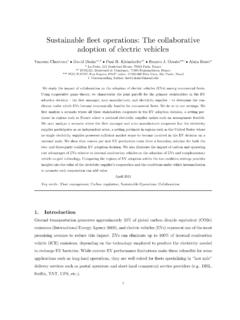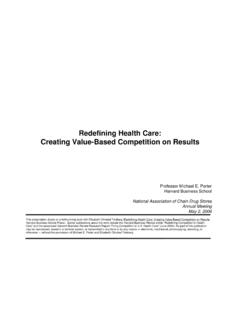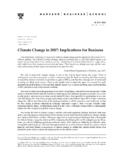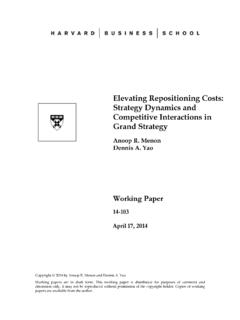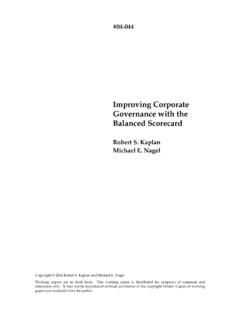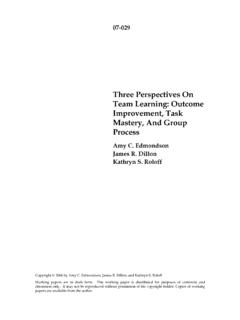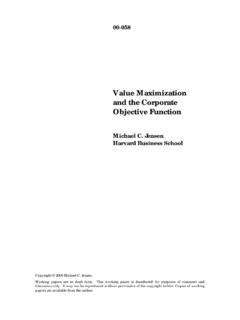Transcription of Clusters of Entrepreneurship and Innovation
1 Clusters of Entrepreneurship and Innovation Aaron Chatterji, Edward Glaeser, William Kerr April 2013. Abstract: This paper reviews recent academic work on the spatial concentration of Entrepreneurship and Innovation in the United States. We discuss rationales for the agglomeration of these activities and the economic consequences of Clusters . We identify and discuss policies that are being pursued in the United States to encourage local Entrepreneurship and Innovation . While arguments exist for and against policy support of entrepreneurial Clusters , our understanding of what works and how it works is quite limited.
2 The best path forward involves extensive experimentation and careful evaluation. Keywords: Entrepreneurship , Innovation , agglomeration, cluster , place making. JEL Classification: H70, L26, L52, L53, M13, O25, O38, R00, R10, R12, R50. Author institutions and contact details: Chatterji: Duke University, Glaeser: Harvard University and NBER, Kerr: Harvard University and NBER, Acknowledgments: This paper has been prepared for the Innovation Policy and the Economy Forum, April 2013. We thank Josh Lerner, Erin Scott, and Scott Stern for helpful comments. 1. 1. Introduction For many decades, the common wisdom among local officials pursuing employment growth for their areas was to attract a large firm to relocate.
3 This smokestack chasing led to many regional governments bidding against each other and providing substantial incentives to large plants making their location choice decisions ( , Greenstone et al. 2010). The success of entrepreneurial Clusters in recent decades, however, has challenged this wisdom, and now many policy makers state that they want their regions to be the next Silicon Valley. This has led to extensive efforts to seed local Entrepreneurship ( , Lerner 2009), with today's politicians routinely announcing the launch of an entrepreneurial cluster in a hot industry, such as biotechnology, nanotechnology, or advanced manufacturing.
4 In this paper, we explore the rationale for and efficacy of policies to promote local Entrepreneurship and Innovation and reflect on recent initiatives in this domain. Section 2 provides a conceptual introduction to industrial/ Innovation policy that grounds the later empirical discussions. The move away from smokestacks to small-scale Entrepreneurship is understandable given the strong correlation between small establishment size and local economic development (Glaeser et al. 2010, 2012). Section 3 discusses the link between Entrepreneurship and Innovation and local economic growth. Figure 1 highlights a representative graph from this work taken from Glaeser et al.
5 (2012). The horizontal axis of each panel provides a potential way to measure Entrepreneurship around 1982, and the vertical axis of each panel measures the employment growth of the city during 1982-2002. There is a very strong connection between initial Entrepreneurship and subsequent employment growth. While striking, there could be many factors behind this correlation, and we discuss the existing, but still nascent, evidence in order to establish causal connections. We also identify some recent studies that look at the impact of local Innovation on regional economic performance. While it is possible to have pro- Entrepreneurship policies that are not tied to cluster - making, supporting a cluster of small-scale entrepreneurs allows policy makers to affect many entrepreneurs simultaneously, providing important scale to their policy interventions, and appears to respect the empirical tendency of economic activity to cluster .
6 Section 4 reviews the extent to which we see economic activity spatially concentrated. Clusters of related businesses exist in most sectors of the economy and have been present throughout modern economic history. We further discuss the extent to which forms of high-impact Entrepreneurship ( , venture capital) and patenting display additional concentration above and beyond that of general economic activity. 2. Section 5 then turns to the local traits of places that correspond to higher Entrepreneurship levels. Relative to the literature that seeks to link local Entrepreneurship to growth, the literature on spatial determinants of Entrepreneurship in Section 5 is more established.
7 We review factors that have been found important at the city level: education, age structure, local entrepreneurial culture, and physical infrastructure. We also consider evidence regarding industry linkages within cities, such that the local industrial composition favors start-ups in one sector over another, and the role of skilled immigrants for spatial variations in Innovation levels and Entrepreneurship for technical fields. At the end of this section, we discuss some open questions about access to cluster benefits with which researchers are currently grappling. Section 6 discusses recent policy initiatives at the federal and local level to encourage Entrepreneurship and Innovation .
8 We first outline some of the goals of these policies, especially as they relate to Entrepreneurship and Innovation . We highlight the variety of recent efforts to increase the local supply of entrepreneurs, especially through education initiatives, or the availability of entrepreneurial finance. We also review the varied role of policy in the development of three well-known innovative Clusters : Silicon Valley, Boston's Route 128. corridor, and North Carolina's Research Triangle Park. A common theme in many of these discussions is the importance of correct baseline business environments, or setting the table.
9 Activities, relative to targeted interventions. Finally, we discuss the recent emphasis on promoting high-growth Entrepreneurship at the federal level. We close the paper with some conclusions and a call for further experimentation on this important question. 2. Industrial Policy, Entrepreneurship and Clusters Since Alexander Hamilton wrote his Report on Manufactures, American governments have tried to actively prod one or more sectors of the economy to grow. There is an even stronger tradition of industrial policy outside of the United States. Sometimes these policies are justified by an obvious market failure, but often they reflect a public desire to appear to be doing something to engineer economic growth from the top down.
10 While it is hard to clearly document whether the benefits of industrial policy exceed the costs, it is easy to provide plausible stories that justify public interventions to aid new or old industries in declining areas or in areas that are just taking off. Three classes of justification are more common: externalities, redistribution, and credit constraints. First, Entrepreneurship or industrial policy helps internalize externalities. If governments will benefit from taxes paid by a successful firm in the future, then it may make sense to aid the firm up front with public subsidy: tax breaks to million-dollar plants can be seen as an up-front payment compensating the plant for the future taxes that the local government will extract from them.
